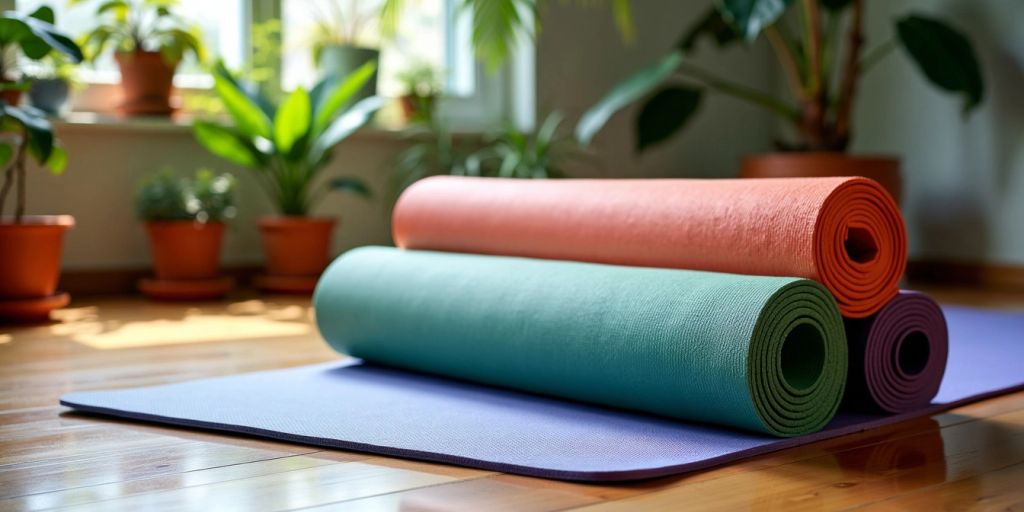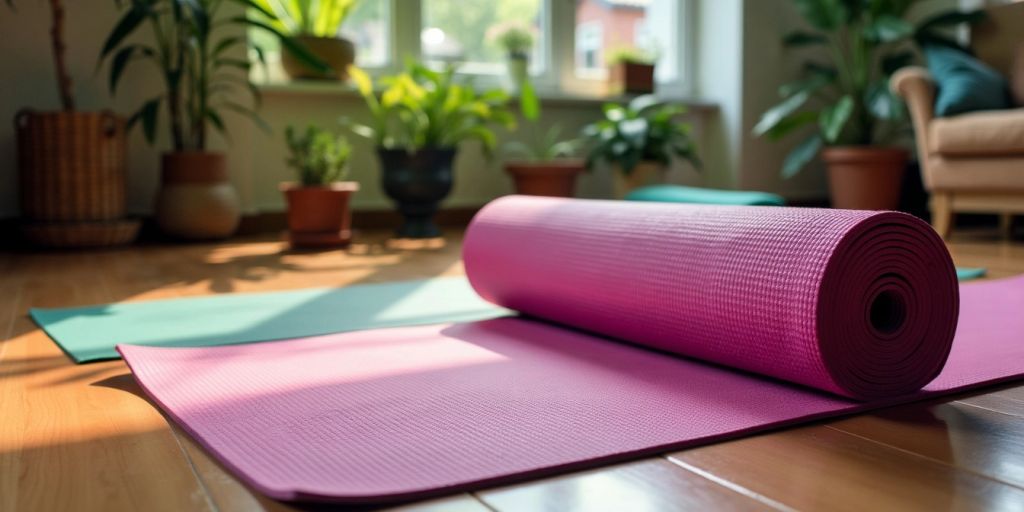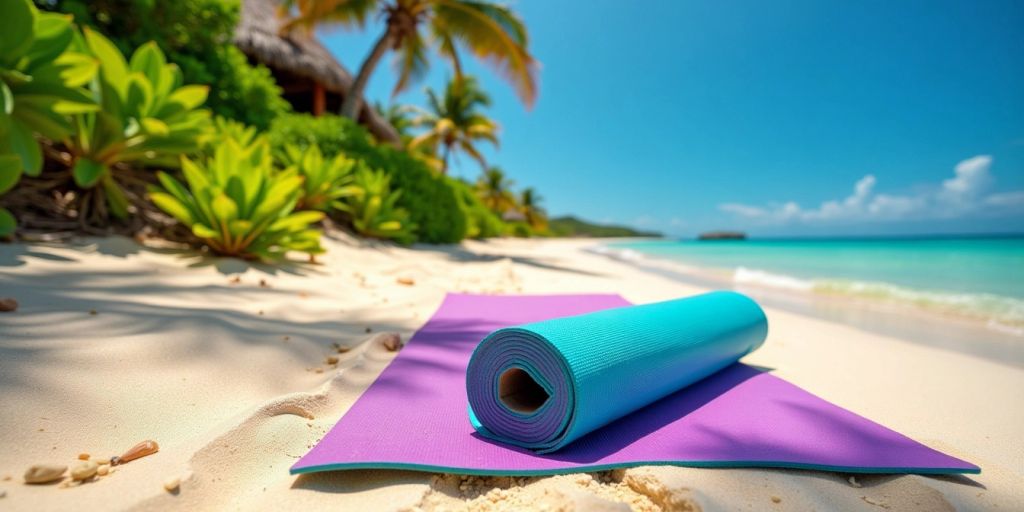
The Ultimate Guide to Choosing the Perfect Exercise Yoga Mat
Choosing the right yoga mat is essential for anyone looking to enhance their yoga practice. With so many options available, it can be overwhelming to find the perfect one. This guide breaks down everything you need to know, from materials and thickness to grip and care tips, helping you make an informed choice that suits your needs.
Key Takeaways
- Select a mat made from natural materials for better grip and comfort.
- Thickness matters; thinner mats are great for stability, while thicker ones provide more cushioning.
- Look for mats with non-slip surfaces to prevent slipping during your practice.
- Eco-friendly mats are available, so consider sustainable options for your purchase.
- Regular cleaning and proper storage can extend the life of your yoga mat.
Understanding Different Materials for Exercise Yoga Mats

When it comes to choosing a yoga mat, the material plays a crucial role in your practice. Here’s a breakdown of the most common types:
Natural Rubber Mats
Natural rubber mats are made from the sap of rubber trees. They are biodegradable and provide excellent grip, making them a great choice for those who want an eco-friendly option. However, people with latex allergies should avoid these mats.
PVC Mats
PVC (polyvinyl chloride) mats are popular due to their durability and affordability. They offer good grip but are not biodegradable, which raises concerns for environmentally conscious users. Here’s a quick comparison:
| Feature | PVC Mats | Natural Rubber Mats |
|---|---|---|
| Durability | High | Moderate |
| Eco-Friendliness | No | Yes |
| Grip | Good | Excellent |
TPE Mats
TPE (thermoplastic elastomer) mats are a newer option that combines plastic and rubber. They are more eco-friendly than PVC and are recyclable. TPE mats provide decent grip and cushioning, making them suitable for various yoga styles.
Cork Mats
Cork mats are made from the bark of cork trees, making them sustainable and renewable. They offer a natural grip that improves when wet, which is perfect for hot yoga. Additionally, cork mats are antimicrobial and easy to clean.
Choosing the right material for your yoga mat can enhance your practice and align with your values. Consider your priorities, such as grip, comfort, and environmental impact, when making your choice.
Choosing the Right Thickness for Your Exercise Yoga Mat
When it comes to yoga mats, the thickness you choose can greatly affect your practice. Here’s a simple guide to help you understand the different thickness options available:
Benefits of Thin Mats
- 1/16 inch (1.5mm): These are ultra-thin mats, often called "travel mats." They are lightweight and easy to carry, making them great for yogis on the go. However, they offer minimal cushioning, which might not be suitable for those with sensitive joints.
Advantages of Thick Mats
- 1/8 inch (3.2mm): This is the standard thickness for most yoga mats. It strikes a good balance between cushioning and stability, making it suitable for various yoga styles.
- 1/4 inch (6.4mm): Thicker mats provide extra cushioning, ideal for restorative or yin yoga practices. They are also beneficial for those with sensitive knees or joints, but can make balancing poses more challenging.
Finding the Perfect Balance
Choosing the right thickness is essential for comfort and stability. Here’s a quick summary of what to consider:
| Thickness | Best For |
|---|---|
| 1/16 inch (1.5mm) | Travel and portability |
| 1/8 inch (3.2mm) | General use and stability |
| 1/4 inch (6.4mm) | Restorative practices and sensitive joints |
Finding the right thickness can significantly enhance your yoga practice by providing the right balance of comfort and stability.
In conclusion, the thickness of your yoga mat can impact your overall experience. Testing different options is recommended to find the best fit for your individual needs. Consider your body weight, intended use, and practice environment when making your choice.
Importance of Grip and Texture in Yoga Mats
When practicing yoga, having a mat with the right grip and texture is crucial. A good grip helps you stay stable and prevents slipping, especially during challenging poses. Here’s a closer look at the key aspects:
Non-Slip Surfaces
- Look for mats that have a textured surface. Textured mats offer [better grip and are less likely to cause slipping](https://yoga-journaling.com/blogs/yoga-lifestyle/top-5-things-to-consider-when-buying-a-yoga-mat?srsltid=AfmBOoqu4_0lANyqDPrKD8eZuSHx1-76J8F78WmiM-8TZcRHpUxN-7OK), even during sweaty sessions. This is essential for maintaining your balance and alignment.
- Some mats are designed to become stickier when wet, which can be beneficial for hot yoga or intense workouts.
Textured vs. Smooth Mats
- Textured Mats: These mats provide a firmer grip and are ideal for dynamic styles of yoga. They can range from subtle patterns to raised ridges, enhancing stability.
- Smooth Mats: While they may feel comfortable, they can be slippery, especially if you sweat a lot. They are better suited for gentle practices.
Grip for Different Yoga Styles
- For styles like Vinyasa or Ashtanga, a mat with excellent grip is essential to prevent slipping during fast-paced movements.
- In contrast, restorative yoga may allow for a smoother mat, as the focus is on relaxation rather than movement.
Choosing the right mat can significantly enhance your practice, making it safer and more enjoyable.
In summary, the grip and texture of your yoga mat play a vital role in your practice. Make sure to consider these factors when selecting your perfect mat!
Eco-Friendly and Sustainable Yoga Mat Options
When it comes to choosing a yoga mat, eco-friendliness is a key factor for many yogis. Here are some sustainable options to consider:
Biodegradable Materials
- Natural Rubber: Made from rubber trees, these mats are biodegradable and provide excellent grip. They are a great choice for those who want to support the environment while practicing yoga.
- Cork: This material is renewable and offers a natural grip that improves when wet, making it perfect for hot yoga. Cork mats are also antimicrobial, which helps keep them clean.
Recycled and Upcycled Mats
- TPE Mats: These are made from a blend of plastic and rubber polymers. They are often recyclable and provide a good balance of grip and cushioning. Some brands even use recycled materials to create these mats.
- Recycled PVC: While traditional PVC is not eco-friendly, some companies are now producing mats from recycled PVC, reducing waste and environmental impact.
Certifications to Look For
When shopping for an eco-friendly yoga mat, look for certifications that indicate sustainable practices. Some important certifications include:
- OEKO-TEX: Ensures that the mat is free from harmful substances.
- GreenGuard: Indicates low chemical emissions, making it safer for indoor use.
Choosing an eco-friendly yoga mat not only enhances your practice but also helps protect our planet. By selecting materials like natural rubber or cork, you can enjoy your yoga sessions while being kind to the environment.
In summary, there are many options available for those looking to practice yoga sustainably. Whether you prefer natural rubber, cork, or recycled materials, you can find a mat that meets your needs and supports your values.
Caring for Your Exercise Yoga Mat
To keep your yoga mat in great shape, follow these simple care tips:
Cleaning Tips
- Regular cleaning is important to maintain hygiene. Use a mild soap solution or a mat-specific cleaner. Some mats are even machine washable; if yours is, wash it on a cold gentle cycle.
- Wipe down your mat after each use to remove sweat and dirt.
Storage Solutions
- Always roll your mat with the top side facing out to prevent curling.
- Store it in a cool, dry place away from direct sunlight to avoid damage.
- Using a mat bag can help protect it from dust and dirt.
Extending the Lifespan of Your Mat
- Rotate your mat's use to ensure even wear and tear.
- Avoid wearing shoes on the mat to prevent punctures and tears.
- Regularly check for any signs of damage and fix them quickly to keep your mat performing well.
Proper care and storage can significantly extend the life of your yoga mat, ensuring you get the best value for your investment.
By following these tips, you can enjoy your yoga mat for many years, enhancing your overall yoga experience. Remember, a well-cared-for mat not only looks better but also performs better!
Top Brands for Exercise Yoga Mats

When it comes to choosing the right yoga mat, knowing the top brands can make a big difference. Here are some of the best options available:
Premium Brands
- Brand A: Known for its high-quality rubber mats, Brand A is a favorite among eco-conscious yogis. Their mats are durable and provide excellent grip, making them perfect for various yoga styles.
- Brand B: This brand is recognized for its innovative designs and comfort. Their mats offer great support, ideal for both beginners and experienced practitioners.
- Brand C: A top choice for professional yogis, Brand C's mats are praised for their superior grip, even during intense sessions. They focus on sustainability, using natural materials in their production.
Budget-Friendly Options
- Brand D: Offers affordable mats that still provide decent quality. Great for beginners who are just starting their yoga journey.
- Brand E: Known for its value, Brand E provides mats that are functional and easy on the wallet, making them a popular choice for casual yogis.
Popular Choices Among Yogis
- Manduka PROlite: A favorite for its durability and comfort, this mat is often recommended for various yoga practices.
- Jade Harmony: This mat is loved for its eco-friendly materials and excellent grip, making it a top pick for many yogis.
Choosing the right brand can enhance your yoga experience. Investing in a quality mat ensures better performance and longevity.
| Brand | Price Range | Key Features |
|---|---|---|
| Brand A | $80 - $120 | Eco-friendly, durable, great grip |
| Brand B | $60 - $100 | Comfortable, stylish designs |
| Brand C | $100 - $150 | Premium quality, excellent grip |
| Brand D | $20 - $50 | Affordable, decent quality |
| Brand E | $30 - $70 | Functional, budget-friendly |
Special Features to Consider in Yoga Mats
When selecting a yoga mat, there are several special features that can enhance your practice and make your sessions more enjoyable. Here are some key aspects to consider:
Portability and Travel Mats
- Lightweight Design: Choose mats that are easy to carry, especially if you travel often for yoga.
- Carrying Straps: Look for mats that come with straps or bags for added convenience.
Customizable Designs
- Personal Touch: Custom yoga mats allow you to express your style with unique designs and colors.
- Enhanced Comfort: These mats can also provide better grip and cushioning, making them ideal for those with joint pain or balance issues. A unique yoga mat can help you stand out in class and achieve your fitness goals.
Extra-Wide and Long Mats
- More Space: If you need extra room for your practice, consider wider or longer mats. This is especially useful for larger poses or if you practice with a partner.
- Comfort for All: These mats can accommodate various body types and styles, ensuring everyone has enough space to practice comfortably.
A well-designed yoga mat not only supports your physical practice but also adds an element of joy and inspiration to your yoga journey.
By considering these special features, you can find a yoga mat that not only meets your needs but also enhances your overall experience. Whether you prioritize portability, customization, or size, the right mat can make a significant difference in your practice.
Final Thoughts on Choosing Your Ideal Yoga Mat
In conclusion, picking the right yoga mat is essential for a great practice. A good mat gives you comfort, grip, and support, making your yoga sessions more enjoyable. Remember to think about the material, thickness, and how easy it is to clean. Whether you prefer natural rubber or eco-friendly options, there’s a mat out there that fits your needs. Take your time to explore different choices, and don’t hesitate to ask for help if you need it. With the right mat, you’ll be ready to roll out and enjoy your yoga journey!
Frequently Asked Questions
What are the main benefits of using a rubber yoga mat?
Rubber yoga mats are good for the environment, last long, and give you great grip and comfort when practicing.
How do I pick the right thickness for my yoga mat?
Think about what feels comfortable for you. Thicker mats are softer, while thinner ones help you stay stable.
What is the best way to clean my rubber yoga mat?
Use a gentle soap and water mix to clean your mat, and let it air dry. Keep it out of direct sunlight to avoid damage.
What are the differences between rubber and PVC yoga mats?
Rubber mats are better for the environment and have better grip, while PVC mats are usually cheaper but not as eco-friendly.
Which brands are known for making good rubber yoga mats?
Some popular brands for rubber yoga mats include Brand A, Brand B, and Brand C, which are known for their quality.
How can I find sales or discounts on rubber yoga mats?
Check the brand's website for sales, sign up for their newsletters, or look at online shops for discounts.


